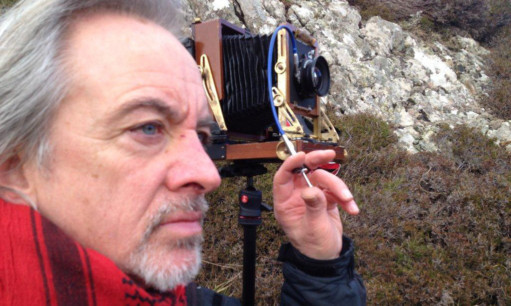East Neuk visual artist Scott Morris has been thinking a lot about the impermanence of life recently.
The death of his mum Isabelle and dad John in 2013 and 2014 respectively has made him reflect a lot on mortality, and he has explored the emotional response to life and death, and the ups and downs of it all, through his work.
Now, that deep exploration of his inner-mood has resulted in a collection of unusual photographic images which capture not only the stunning character of the island of Iona, but did so using a camera and techniques rooted way before the digital age.
Inspired by his ‘Twelve month and a day’ project which saw him take a picture of himself every day for a year in 2012 to capture his inner-mood, Scott won a four-week placement as artist-in-residence on Iona.
And now back home in Anstruther, the experience has left him feeling refreshed and eager to try out some of the photographic techniques again.
“I wanted to reflect on the impermanence of life and physical objects and my emotional response to life and the imperfections of it all, “ he told The Courier.
“I stayed in a shepherd’s bothy on Iona for four weeks with no running water or cooking facilities. For that I used the nearby youth hostel which was run by John MacLean.
“Instead of using digital images which are so clear, bright and colourful, I wanted something altogether different. Something other wordly, something out of time.
“So my project focused on the use of analogue photography. I used a 5×4 wooden field camera to take a picture each day to reflect how Iona made me feel. The design of this camera is generally from the 19th century. I took a Japanese one from the 1970s made of cherry wood and brass. I also took a Polaroid camera.”
Scott used a photographic technique, dating back to 1834, where he took Atlantic seawater, boiled it, diluted it, put it onto water-colour paper and let it dry. Then in very low light he coated the paper in silver nitrate that made it photo-sensitive. Exposing the negative to UV light then gave him a salt print.
To go with each picture he wrote a haiku (a traditional form of Japanese poetry consisting of three lines). He also wanted to recognise the wabi-sabi which represents Japanese aesthetics and a world view centred upon the acceptance of transience and imperfection in modest and humble things and things that are unconventional.
He added: “When I went to Iona I didn’t want to take conventional pictures of the island. I felt Iona was already a special place. The Abbey was built there because it was a special place. That’s why I didn’t go there until the end of my trip. I felt as if I went to the Abbey at the start, I might concentrate on the Abbey too much, and it wasn’t supposed to be about that.”
Scott said the experience of staying in the bothy, away from his normal environment, was an important part of his trip. The weather also played a role with heavy storms cutting the island off during the early part.
But amid the changeable conditions he also managed to converse with nature where he experienced a number of life affirming moments.
He added: “The last three years have not been easy. I’ve been reflecting on life in general. Iona was an interesting project but it’s also been a personal journey for me.
“In my final week for example I managed to go sea swimming five times. Once when I was getting changed an otter stopped by, and I saw a young seal crawling by.
“During my final swim, it was one of those bright days with ice on the puddles and yet the sea was so inviting. I could see the moon in one part of the sky, the sun in the other part of the sky and snow on the hills. It was a special moment.”
Scott held an exhibition on Iona to which 30 people attended.
He is now looking forward to an open studio event from Friday March 25 until Monday March 28 at Ovesntone in the East Neuk. It’ll be called ‘Iona – through a glass darkly’.
He also hopes to exhibit during the Pittenweem Arts Festival in August and is looking forward to trying out some of the salt print techniques using water from the Firth of Forth.
